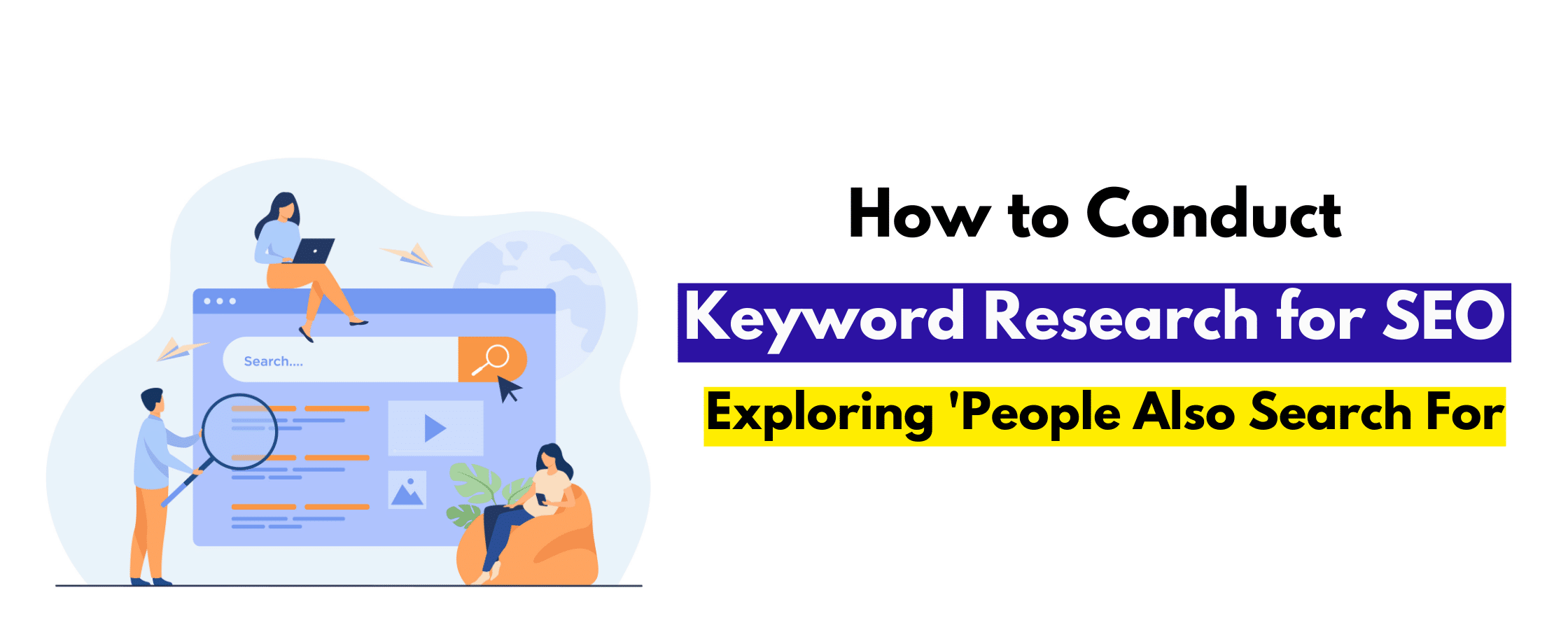How to Conduct Keyword Research for SEO: Exploring ‘People Also Search For
In the world of search engine optimization (SEO), conducting thorough keyword research is crucial for businesses and websites to achieve online visibility and success. One of the valuable tools available for conducting keyword research is the “People Also Search For” feature that appears in search engine results pages (SERPs).
This feature provides related queries that people often search for in addition to the original search query. Exploring “People Also Search For” can help businesses and websites identify additional keywords and phrases that potential customers are searching for.
In this guide, we will explore how to conduct keyword research for SEO by exploring “People Also Search For.” We will discuss the benefits of this feature and how it can help you to identify new opportunities and gain a better understanding of your target audience’s organic search behaviour.
Additionally, we will provide a step-by-step guide on how to use “People Also Search For” in your keyword research strategy to improve your website’s online visibility and drive more traffic to your business.
Table of Contents
- What is “People Also Search For”?
- How is “People Also Search For” Generated?
- Why Explore “People Also Search For” in Keyword Research?
- Examples of “People Also Search For” in Search Engine Results Pages (SERPs)
- How to Conduct Keyword Research with “People Also Search For”
- Final Thoughts
- Frequently Asked Questions
What is “People Also Search For”?
“People Also Search For” is a feature that appears in search engine results pages (SERPs) below the main search results. It provides related queries that people often search for in addition to the original search query.
For example, if someone searches for “best coffee shops in New York City,” the “People Also Search For” feature might display related queries like “best coffee shops in Brooklyn” or “best coffee shops with free Wi-Fi.”
Exploring “People Also Search For” can help businesses and websites identify additional keywords and phrases that potential customers are searching for.
How is “People Also Search For” Generated?
“People Also Search For” is generated through algorithms that analyze search queries and search patterns to provide related queries that people often search for in addition to the original query.
This feature is designed to help users find what they’re looking for more easily and provide additional information that may be helpful or relevant to their search.
The algorithms take into account various factors, such as search volume, user intent, and relevancy, to generate the related queries displayed in the “People Also Search For” feature.
Click here to also read ‘How Google search works’.
Why Explore “People Also Search For” in Keyword Research?
There are several benefits of exploring “People Also Search For” in keyword research for SEO, including:
- Identify Additional Relevant Keywords: By exploring “People Also Search For,” you can identify additional keywords and phrases related to your main search query that people are searching for. This helps to expand your keyword list and improve the relevance of your content.
- Improve User Experience: When you incorporate “People Also Search For” related queries right keywords into your content, it can help to provide a better user experience by answering related questions that users may have.
- Stay Ahead of Competitors: By identifying additional relevant keywords, you can stay ahead of your competitors and target new keywords, that they may have missed.
- Increase Search Engine Visibility: By targeting additional relevant keywords, you can improve your search engine visibility and increase the likelihood of appearing in search engine results pages (SERPs).
Examples of “People Also Search For” in Search Engine Results Pages (SERPs)

- If you search for “best coffee shops,” “People Also Search For” might show you related q ueries such as “best coffee shops near me,” “best coffee shops in NYC,” or “best coffee shops with free wifi.”
- If you search for “healthy recipes,” it might show you related queries such as “healthy dinner recipes,” “healthy smoothie recipes,” or “healthy vegetarian recipes.”
- If you search for “dog training tips,” it might show you related queries such as “dog obedience training,” “how to potty train a puppy,” or “dog training classes near me.
- If you search for “best coffee shops in New York City” on Google, you might see related queries like “best coffee in NYC”, “best coffee roasters in NYC”, and “best coffee shops in Brooklyn”.
- If you search for “how to start a blog” on Google, you might see related queries like “how to make money blogging”, “how to write a blog post”, and “how to get more blog readers”.
- If you search for “best yoga mats” on Google, it will show related queries like “best eco-friendly yoga mats”, “best yoga mats for beginners”, and “best cheap yoga mats”.
How to Conduct Keyword Research with “People Also Search For”?
Keyword research is a crucial aspect of search engine optimization (SEO) and “People Also Search For” can be a valuable tool for finding related queries to improve your SEO strategy. In this section, we’ll explore how to conduct effective keyword research using “People Also Search For” and provide tips and best practices for utilizing this feature to enhance your SEO efforts.
Step-By-Step Guide on How to Use “People Also Search For” in Keyword Research
Here is a step-by-step guide on how to use “People Also Search For” in keyword research:
- Start with a broad keyword: Begin by typing a broad keyword related to your business or n
- iche into a search engine, such as Google.
- Scroll down to “People Also Search For”: On the search engine results page (SERP), scroll down to the “People Also Search For” section. This section will show you related queries that people often search for.
- Identify relevant keywords: Review the related queries and identify keywords and phrases that are relevant to your business or niche.
- Repeat the process: Use the identified keywords to search again, and continue the process of identifying related queries until you have a comprehensive list of relevant keywords.
- Analyze the data: Use keyword research tools, such as Google Keyword Planner, to analyze the search volume, competition, and trends of the identified keywords. This will help you to prioritize and target the most relevant keywords.
Tips and Best Practices for Conducting Keyword Research with “People Also Search For”
Here are some tips and best practices for conducting keyword research with “People Also Search For”:
- Be specific: Use specific keywords to generate more targeted and relevant related queries.
- Consider user intent: Think about the intent behind the search and identify related queries that answer user questions and provide value.
- Use keyword research tools: Utilize keyword research tools to analyze the search volume, competition, and trends of the identified keywords.
- Prioritize keywords: Prioritize keywords based on relevance, search volume, and competition.
- Incorporate keywords into content: Incorporate the identified keywords into your content to improve relevance and increase search engine visibility.
Tools and Resources for Utilizing “People Also Search For” in Keyword Research
Here are some tools and resources for utilizing “People Also Search For” in advanced search and keyword research:
- Google Keyword Planner: A free keyword research tool that provides insights into search volume, competition, and trends.
- SEMrush: A keyword research tool that provides detailed insights into keyword trends, competition, and search volume.
- Moz Keyword Explorer: A keyword research tool that provides insights into search volume, difficulty, and opportunity.
- Ahrefs: A keyword research tool that provides insights into keyword search volume, difficulty, and related keywords.
- Google Trends: A free tool that provides insights into keyword trends and popularity over time.
Final Thoughts
In conclusion, exploring “People Also Search For” can be a valuable tool in conducting keyword research for SEO. By analyzing related queries that people often search for in addition to the initial search query, businesses and websites can identify additional keywords and phrases that potential customers are searching for.
We have discussed the benefits and advantages of exploring “People Also Search For” in keyword research, provided a step-by-step guide on how to use it for keyword results, and highlighted examples of successful keyword research with “People Also Search For.”
It’s important to note that while “People Also Search For” is a useful tool, it shouldn’t be the only tool used in keyword research. Other keyword research tools and strategies, such as Google Keyword Planner, competitor analysis, and social listening, should also be utilized to achieve comprehensive and effective keyword research.
In summary, by incorporating “People Also Search For” into your keyword research strategy, you can identify new opportunities for keyword ideas and gain a better understanding of your target audience’s search behaviour, ultimately leading to SEO success and increased traffic to your website or business.
Thank you for reading through to the end. Do check out our blog ‘On Page and Off Page SEO: What’s The Difference?’
Frequently Asked Questions
What is people also search for on Google?
“People Also Search For” is a feature on Google search results page that displays related queries to the initial search term. It helps users refine their search and provides additional ideas for related topics.
What is the difference between related searches and people also search for?
Related Searches and People Also Search For are similar features on Google’s search engine results page that show related queries to a user’s initial search term. However, People Also Search For provides more specific and detailed queries related to the original search term based on user data and search patterns.
What does it mean by search term?
Search terms are keywords users use when looking through search engines for information about something specific. Search terms or phrases are often categorized into keywords or words like “dentist” and “dentist Boston implant”.
How do I find a search term?
To find a search term, think of the specific topic or question you want to search for and enter it into the search bar of a search engine, such as Google. Alternatively, use a keyword research tool to find popular and relevant search terms related to your topic.
What is an example of people also ask?
“People Also Ask” is a feature on Google’s search engine results page that displays related questions to the initial search term. An example of a “People Also Ask” question for the search term “best camera for photography” could be “What is the best DSLR camera for beginners?”
How does Google generate people also ask questions?
Google generates “People Also Ask” questions using natural language processing (NLP) algorithms that analyze user search data and related queries. As users click on and interact with the questions, Google learns and refines the suggestions to provide more relevant and helpful content.
When did Google add people also ask?
Google added the “People Also Ask” feature to its search engine results page in 2015. The feature has since become a popular and valuable tool for users to find related information and for SEO professionals to conduct keyword research.
What is the number 1 question asked on Google?
The most searched question on Google is constantly changing, but some of the most commonly searched questions include “What time is it?” and “How to tie a tie?”






